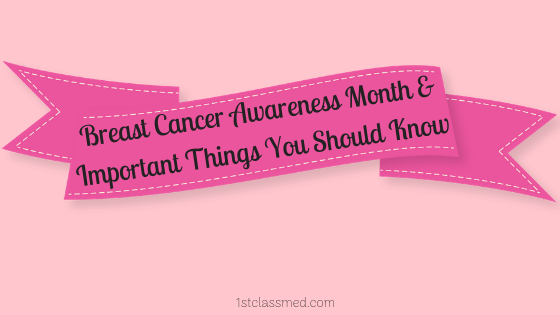
Though we often discuss the lungs and lung health here at 1st Class Medical, this month is Breast Cancer Awareness Month and we felt that it needed to be discussed as well.
Breast cancer is the uncontrollable growth of breast cells, and results from a mutation in the genes.
A tumor can be benign (meaning it is not cancerous and is not a danger to your health) or malignant (meaning it is cancerous and is a danger to your health).
Benign tumors are not cancerous because their cells are normal in appearance, they grow slowly and do not invade tissue or spread.
Malignant tumors are cancerous because their cells will spread if they are not treated.
Breast cancer is when the tumor is malignant, and it develops in the breast.
Breast cancer can develop in both breasts or just one but begins in the lobules which is where milk-producing.
It can also develop in the stromal tissues, which are the fatty and fibrous connective tissue of the breast, but this is a less common form of it.
The cancer can spread to other parts of the body, such as the lymph nodes, and healthy breast tissue.

Stages:
Breast cancer is put into stages, these stages define how much the cancer has spread beyond the original tumor.
The stages of breast cancer range from stage 0 to stage IV, stage 0 being a non-invasive cancer with no evidence of cancer cells or non-cancerous abnormalities and stage IV being a widespread cancer that has gone beyond the breasts and could be in the lymph nodes, lungs, skin, bones, liver or brain.
Stage 0 is no evidence of the cancer spreading or breaking out of the part of the breast in which they started.
Stage I described invasive breast cancer (it is broken down to 2 categories), which means the cancerous cells are breaking through or invading normal surrounding tissue.
Stage IA is invasive breast cancer where the tumor is up to 2 cm and the cancerous cells have not yet spread outside the breast.
Stage IB is invasive breast cancer that has no tumor in the breast but has small clumps of cancerous cells (larger than .2 mm but smaller than 2 mm) are found in the lymph nodes, or there is a tumor in the breast smaller than 2 cm and there are cancerous clusters larger than .2 mm but smaller than 2 mm in the lymph nodes.
Stage II is also divided into 2 categories, stage IIA and stage IIB, these stages cover an invasive form of breast cancer.
Stage IIA is when no tumor is found, but cancer is found in 1-3 axillary lymph nodes/lymph nodes near the breast bone, or a tumor is found to be 2 cm or smaller, but has also spread to the axillary lymph nodes, or the tumor is larger than 2 cm but smaller than 5 cm and has not spread to the axillary lymph nodes.
Stage IIB is when the tumor is larger than 2 cm but smaller than 5 cm and there are also small groups of cancerous cells (larger than .2 mm but smaller than 2 mm) in the lymph nodes, or the tumor is larger than 2 cm but smaller than 5 cm, the cancer has spread to 1-3 axillary lymph nodes/breast bone lymph nodes or the tumor is larger than 5 cm but has not yet spread to the axillary lymph nodes.
Stage III has 3 categories, stage IIIA, IIIB and IIIC, these are all very invasive forms of breast cancer.
Stage IIIA is when no tumor is found in the breast or the tumor can be any size, cancer can be found in 4-9 axillary lymph nodes or the lymph nodes near the breast bone, or the tumor is larger than 5 cm, small groups of cancerous cells are found in the lymph nodes or the tumor is larger than 5 cm, cancer has spread to 1-3 axillary lymph nodes, or the lymph nodes near the breast bone.
Stage IIIB is when the tumor is any size and has spread to the chest wall or skin of the breast, causing swelling or an ulcer and it may have spread to up to 9 axillary lymph nodes or the lymph nodes near the breast bone.
Stage IIIC is when there is no sign of cancer in the breast, or if there is a tumor it may be any size and could have possibly spread to the chest wall and/or skin of the breast, or the cancer has spread to 10 or more axillary lymph node, or it has spread to the lymph nodes above or below the collarbone, or it has spread to axillary lymph nodes or to the lymph nodes near the breast bone.
Stage IV is the most extreme form of breast cancer, that is very invasive and has spread beyond the breast and to nearby lymph nodes or other organs, such as the lungs, skin, bones, liver or brain.
This stage is often called advanced or metastatic, it can be diagnosed at stage IV for the first time (called “de novo”) or a reoccurring diagnosis.

Conclusion:
Though women should start getting mammograms between the age of 40 and 44, some choose to start between 45 and 54 and continue to get one every year, as you get older (55 and up) you can switch to getting mammograms every 2 years versus every year.
For those with lung diseases and breast cancer, make sure to inform all doctors of both conditions, as radiotherapy can cause the cells in your lungs to harden and thicken which can make it very hard to breathe.
Once you fit into the age range of getting mammograms, make sure to go every year until your doctor recommends every 2 years, as this can allow for early detection of cancer.
Your health and well being is important, so see your doctor if you notice any pain or lumps in your breasts, before you turn 40 and need to get mammograms every year.



